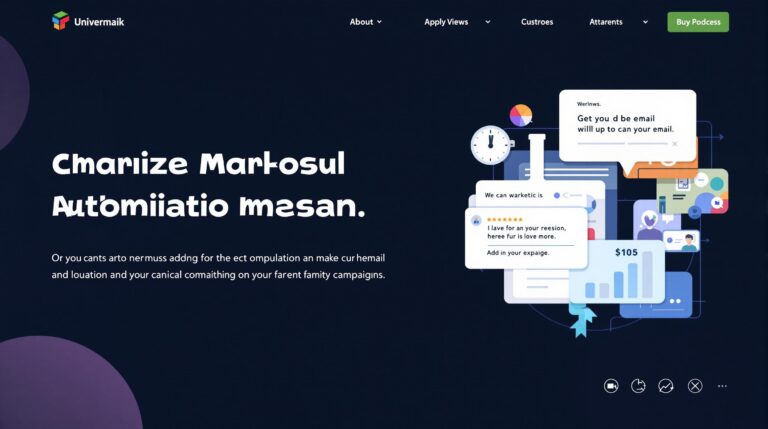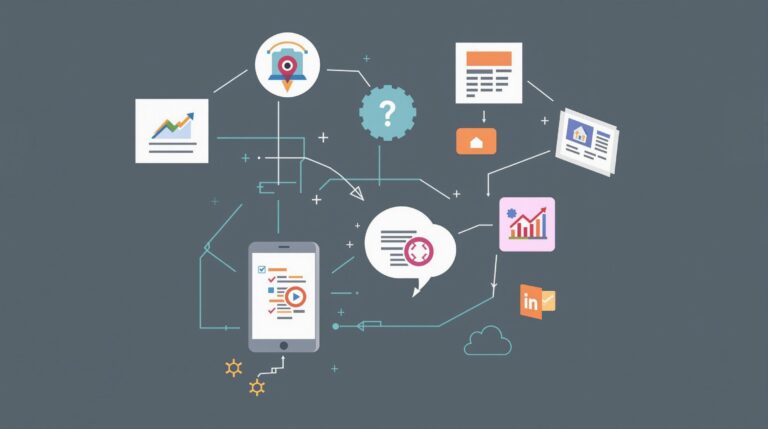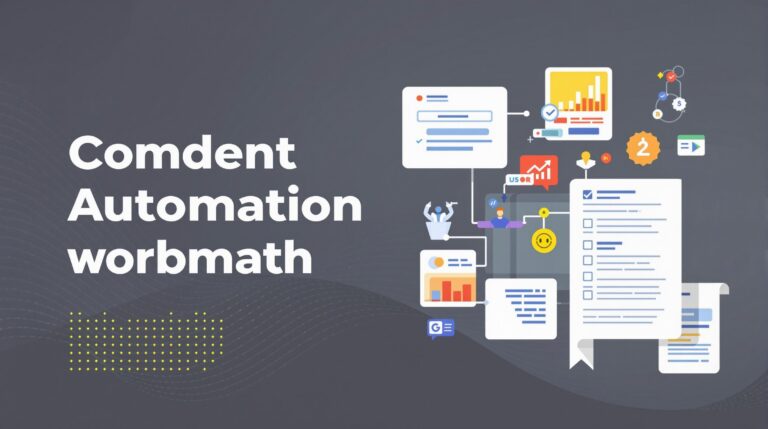Automating Social Media Content: A Step-by-Step Guide
Automating Social Media Content: A Step-by-Step Guide
Social media automation has transformed how brands engage with their 5.22 billion global audience, allowing marketers to reduce manual posting time by up to 60% while maintaining authentic connections. From AI-generated content to scheduled posts across multiple platforms, social media automation tools now offer businesses scalable solutions to maximize engagement and ROI in today’s fast-paced digital landscape.
Key Takeaways
- Marketers typically spend 15+ hours weekly on manual posting; automated social media posting can reduce this by 60%
- Implement the 70/20/10 content rule to balance educational, user-generated, and promotional content
- Businesses earn $5.78 for every $1 spent on influencer marketing, which can be amplified through automation
- Video content dominates engagement with 78% of TikTok and Instagram users preferring short-form videos
- Social automation tools can help maintain consistent posting schedules during peak engagement windows
The Social Media Automation Revolution
The digital landscape has experienced remarkable growth, with social media users increasing by 8% annually. This expansion has added 320 million new users between 2023-2024 alone, creating both opportunities and challenges for marketers. Facebook leads with 3.07 billion users, followed by YouTube with 2.5 billion, making these platforms essential for business visibility.
This explosive growth has triggered a parallel rise in social media advertising, with global spending projected to reach $276.7 billion by 2025. For businesses, the financial benefits are clear – companies earn $5.78 for every $1 spent on influencer marketing when properly optimized through automation. This return highlights why brands are rapidly adopting automated solutions.
Time efficiency represents another compelling reason for automation adoption. Marketing teams typically dedicate more than 15 hours weekly to manual social media posting. By implementing automation, businesses can reduce this time investment by up to 60%, allowing teams to focus on strategy and creativity rather than repetitive tasks.

Planning Your Automation Strategy
Effective social media automation begins with a strategic content framework. I recommend implementing the 70/20/10 content rule as your foundation: 70% educational posts that provide value to your audience, 20% user-generated content that builds community, and 10% promotional offers that drive conversions.
Before diving into automation tools, conduct a thorough audit of your current workflows. Examine your existing content through the 70/20/10 lens to identify specific automation opportunities. This assessment helps determine which processes consume the most time and which would benefit most from automation.
AI tools like ChatGPT can streamline your content planning by generating SEO-optimized keywords and fresh content ideas. This approach ensures your automated content remains relevant and search-friendly while reducing planning time. For timing optimization, schedule your automated posts during platform-specific peak engagement windows – for example, lifestyle brands often see heightened engagement on Saturdays around 11 AM according to Sprout Social.
Content Creation and Visual Automation
Visual content dominates social media engagement, with 78% of TikTok and Instagram users preferring short video content. This preference has made visual automation tools essential for scaling content production. Integrating AI image generators like DALL-E or MidJourney through their APIs allows you to automatically create product visuals from keywords, dramatically accelerating your content pipeline.
For video content, tools like Canva and Adobe Firefly have revolutionized production capabilities. These platforms enable you to automate video creation at scale, turning simple text inputs into professional-looking video content. The efficiency gains are substantial – what once took hours of designer time can now be accomplished in minutes.
One of the most time-consuming aspects of social media management is reformatting content for different platforms. Implementing an automatic resizing workflow addresses this challenge by converting your graphics to platform-specific dimensions:
- Instagram Stories: 1080×1920 pixels
- LinkedIn posts: 1200×627 pixels
- Twitter/X images: 1600×900 pixels
- Facebook link images: 1200×630 pixels
Content repurposing represents another valuable automation opportunity. Tools like Pictory.ai can transform blog posts into 60-second video reels, boosting engagement by approximately 40%. While leveraging these AI tools, remember to maintain your brand voice and authenticity. The most effective automation enhances rather than replaces human creativity, as noted by eclincher.
Cross-Platform Publishing and Scheduling
Efficient cross-platform publishing forms the backbone of any successful automation strategy. Configure scenarios in no-code platforms like Make.com to pull content from RSS feeds, route it to appropriate social channels, and schedule posts according to platform-specific best practices. This approach ensures consistency while respecting the unique requirements of each platform.
When selecting publishing tools, consider comprehensive solutions like Hootsuite, HubSpot Social Media Management, or Later. Each offers distinct advantages, from detailed analytics integration to specialized features for visual-first platforms. The ideal tool depends on your specific business needs and existing marketing technology stack.
While automatic cross-posting between platforms saves time, it’s crucial to respect platform nuances. For example, TikTok’s algorithm favors native video uploads over content that appears cross-posted from other platforms. Making small adjustments to captions, hashtags, and media formats for each platform can significantly impact performance.
The most effective automation strategies balance scheduled content with real-time interactions. As content automation experts emphasize, maintaining authenticity requires human touch points alongside your automated posts. This hybrid approach delivers the efficiency benefits of automation without sacrificing the personal connections your audience expects.
Engagement Automation and Monitoring
Beyond scheduling posts, automating engagement responses can dramatically improve your social media efficiency. Deploy chatbots to handle frequently asked questions while routing more complex queries to human team members. This tiered approach ensures quick responses while preserving quality for issues that require personalized attention.
Automated listening tools have become essential for brands seeking to monitor mentions across platforms. Research shows that responding to mentions within 1-2 hours can significantly impact customer satisfaction. Tools like Sprout Social, Brandwatch, and HubSpot provide comprehensive monitoring capabilities that flag brand mentions requiring attention.
Sentiment monitoring represents another valuable automation application. Configure your monitoring tools to track brand sentiment, automatically flagging negative mentions for immediate response. This proactive approach helps prevent minor issues from escalating into larger reputation problems.
While automating engagement processes, avoid the common pitfall of over-automation. Interactions that feel robotic or impersonal can damage brand perception. The goal should be using automation to enhance human capabilities rather than replace authentic connections. Striking this balance requires regular review of automated responses and continuous refinement of your engagement rules.
Analytics and Performance Optimization
Measuring the effectiveness of your social media automation requires tracking specific performance metrics. For engagement rates, aim for platform benchmarks like 3-6% on Instagram and 1-3% on Facebook. These figures provide context for evaluating your content’s performance and identifying optimization opportunities.
Click-through rates offer another critical metric, particularly for conversion-focused campaigns. Top-performing social ads typically achieve 1.5-3% CTR on Meta platforms, according to recent industry data. Monitoring your CTR against these benchmarks helps identify content that effectively drives traffic to your website or landing pages.
Automated A/B testing represents one of the most powerful optimization tools. Use platforms like HubSpot to automatically test different ad copy variations, identifying which messaging resonates most effectively with your audience. This data-driven approach takes the guesswork out of content optimization.
Lead scoring automation can reduce your Cost Per Lead by 20-30% through creating targeted ad variants. By automatically identifying which content drives the most qualified leads, you can reallocate budget toward high-performing campaigns. Tools like Sprout Social and Hootsuite Analytics facilitate this process by measuring performance across multiple platforms simultaneously.
Software Solutions for Social Media Automation
Selecting the right automation tools depends on your specific needs and existing workflow. For end-to-end solutions, platforms like Make.com offer no-code automation capabilities across multiple platforms, while HubSpot combines scheduling, CRM integration, and analytics in a unified environment.
AI content creation tools have transformed the production process. ChatGPT excels at generating captions and copy, while Adobe Firefly specializes in creating on-brand visuals from text prompts. These tools can dramatically accelerate your content pipeline when integrated into your workflow.
For analytics capabilities, consider dedicated solutions like:
- Sprout Social for detailed engagement metrics and demographic analysis
- Hootsuite for cross-platform performance measurement
- HubSpot for connecting social performance to sales outcomes
Video automation has become increasingly important as platforms prioritize this content format. Tools like Canva, Adobe Firefly, and Pictory.ai offer different approaches to video creation and editing, with varying levels of automation. When selecting tools, I recommend piloting Make.com or HubSpot for 30 days to assess time savings before making a long-term commitment.
Future Trends in Social Media Automation
The future of social media automation is rapidly evolving, with AI-driven personalization at the forefront. By 2026, an estimated 93% of marketers will use AI to dynamically personalize content, creating unique experiences for different audience segments. This shift will enable brands to deliver more relevant messaging without increasing production time.
Video-first strategies continue gaining importance as short-form video dominates engagement metrics. Brands that automate aspects of video production and distribution will gain significant advantages in reach and engagement. This trend makes investing in video automation capabilities increasingly essential for competitive social media presence.
Personalization at scale represents another major trend, with automated systems delivering geo-targeted promotions and demographic-specific content. The ability to customize messaging for different audience segments while maintaining efficiency will be a key differentiator for successful brands.
AI-driven analytics will increasingly predict optimal posting times and content types, moving beyond descriptive analytics to prescriptive recommendations. These predictive capabilities will transform how content strategies are developed and implemented, further enhancing the ROI of social media investments.
Finally, the integration of social commerce with automated inventory and pricing updates will create seamless shopping experiences. This convergence of social media and e-commerce, powered by automation, will enable more direct conversion opportunities while reducing the manual overhead traditionally associated with managing product listings.








